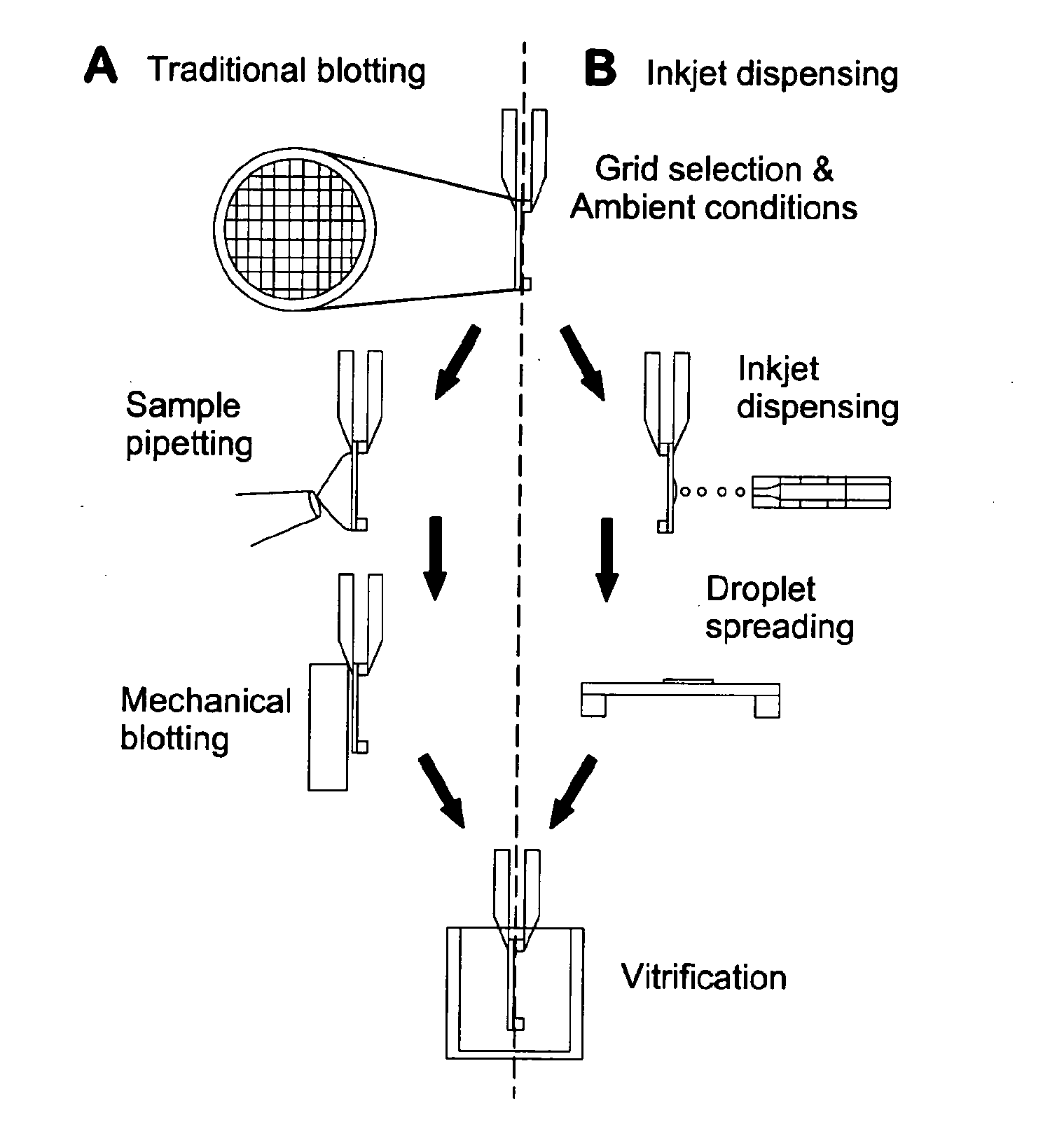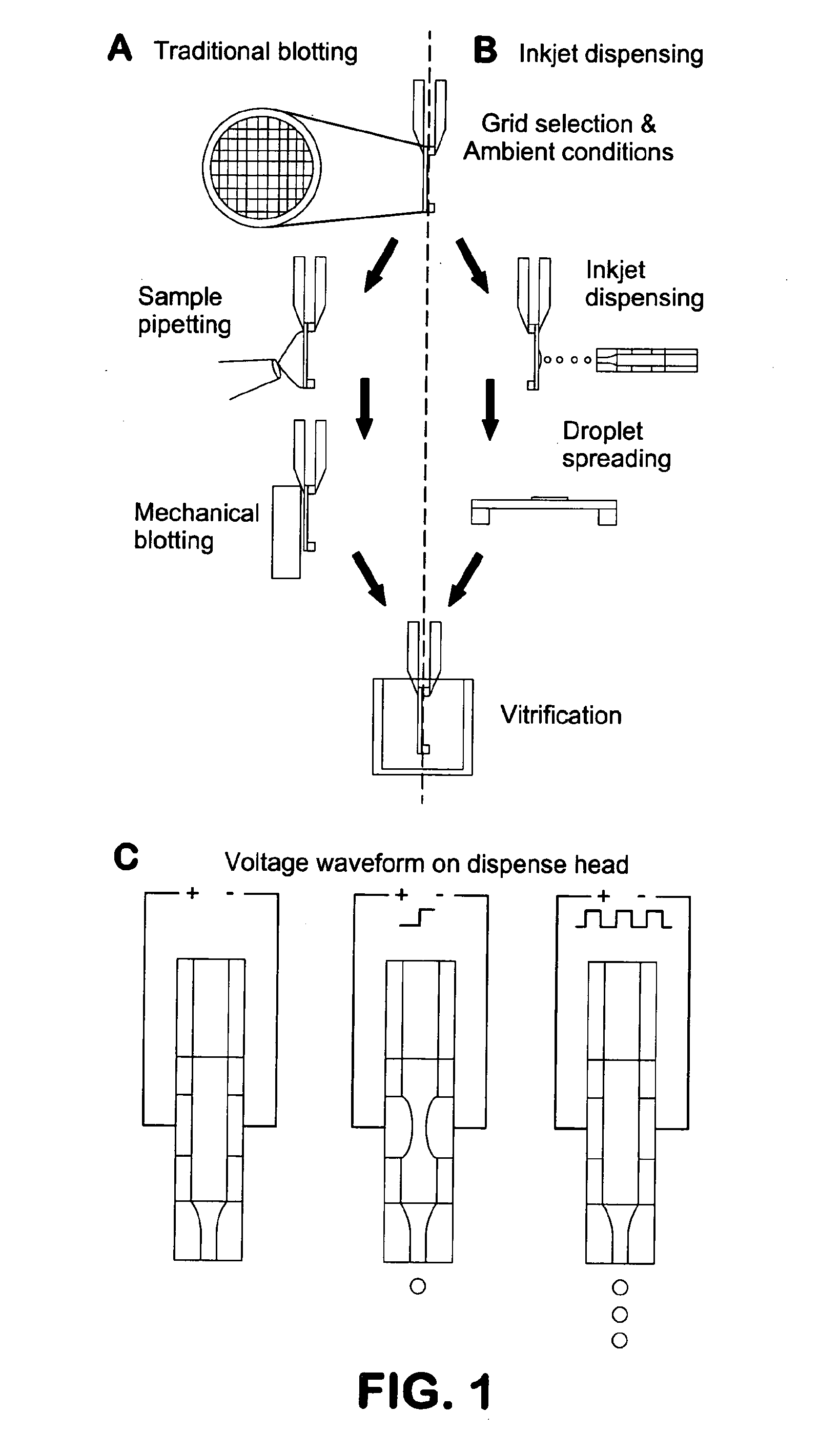Apparatus and Method for Producing Specimens for Electron Microscopy
- Summary
- Abstract
- Description
- Claims
- Application Information
AI Technical Summary
Benefits of technology
Problems solved by technology
Method used
Image
Examples
example 1
[0038]To test if picoliter to nanoliter dispensing of specimen using piezo-electric inkjet technology can be utilized for cryo-TEM, a system that integrated several modules as shown in FIG. 3. A commercially available piezo-electric dispense head was incorporated with central bore size 24 μm. This head was capable of dispensing discrete specimen droplets of 32 pL; observed in-flight using a stroboscopic LED light and side-view lens / camera system that allowed for viewing dispensed droplets at precise time-points (0-100 μsecs) after droplet generation from the head. Specimen dispense was triggered by software via the accompanying piezo-electric head control module and the number of droplets, frequency and droplet velocity could be modified as desired. Rear-view imaging of the grid at an acquisition rate of 100 Hz allowed for visualizing droplet impact, spreading and evaporation dynamics. The rear-view camera was also used to align the grid with the dispense head and provided a way to ...
example 2
[0039]Using the traditional sample pipetting and blotting technique the entire grid is affected, limiting only one specimen to be evaluated per grid during cryo-TEM study. The ability to precisely align and confine droplets on the substrate could open up the possibility to delivery multiple samples per grid, increasing the throughput of experimentation. Inkjet technology allows for precise positioning of dispense heads in relation to grid substrates, which provides a way to spatially control specimen dispensing on a single EM grid. Spatial targeting was confirmed by fluorescence imaging of the specimens (ex / em: 488 / 520 dye) on the grid. Droplet impact and spreading was further studied in hydrophobic and hydrophilic conditions. For untreated carbon grids the contact angle observed was ˜90°, upon droplet dispensing (25 droplets) and image capture. In contrast, when the carbon grids were treated in an Oxygen / Argon plasma discharge, the contact angles reduced considerably to ˜15°. This ...
example 3
[0040]As one of the goals of this new methodology is to eliminate manual blotting, it is important that the samples on the grid be vitrified at time-points when the sample thickness is suitable for cryo-TEM imaging. This can be accomplished by viewing the droplet dynamics (spreading and drying) on the grid in real-time and triggering the plunge process (for vitrification) at an optimal time-point post-dispensing. At the experimental environment conditions (RH 10%, Temperature 25° C.), a single droplet dries (as observable by rear-view imaging) within 300 msec upon impact onto the grid. Under these conditions, higher number of droplets led to longer drying times (and also larger spreading distances on the grid; data not shown). Also, the repeatability of the droplet dynamics (based on drying times) is high for the droplets dispensed on the grid, allowing for automated plunging events to be accurately timed. In the current system, the plunging event is triggered manually by a hand-ope...
PUM
 Login to View More
Login to View More Abstract
Description
Claims
Application Information
 Login to View More
Login to View More - R&D
- Intellectual Property
- Life Sciences
- Materials
- Tech Scout
- Unparalleled Data Quality
- Higher Quality Content
- 60% Fewer Hallucinations
Browse by: Latest US Patents, China's latest patents, Technical Efficacy Thesaurus, Application Domain, Technology Topic, Popular Technical Reports.
© 2025 PatSnap. All rights reserved.Legal|Privacy policy|Modern Slavery Act Transparency Statement|Sitemap|About US| Contact US: help@patsnap.com



